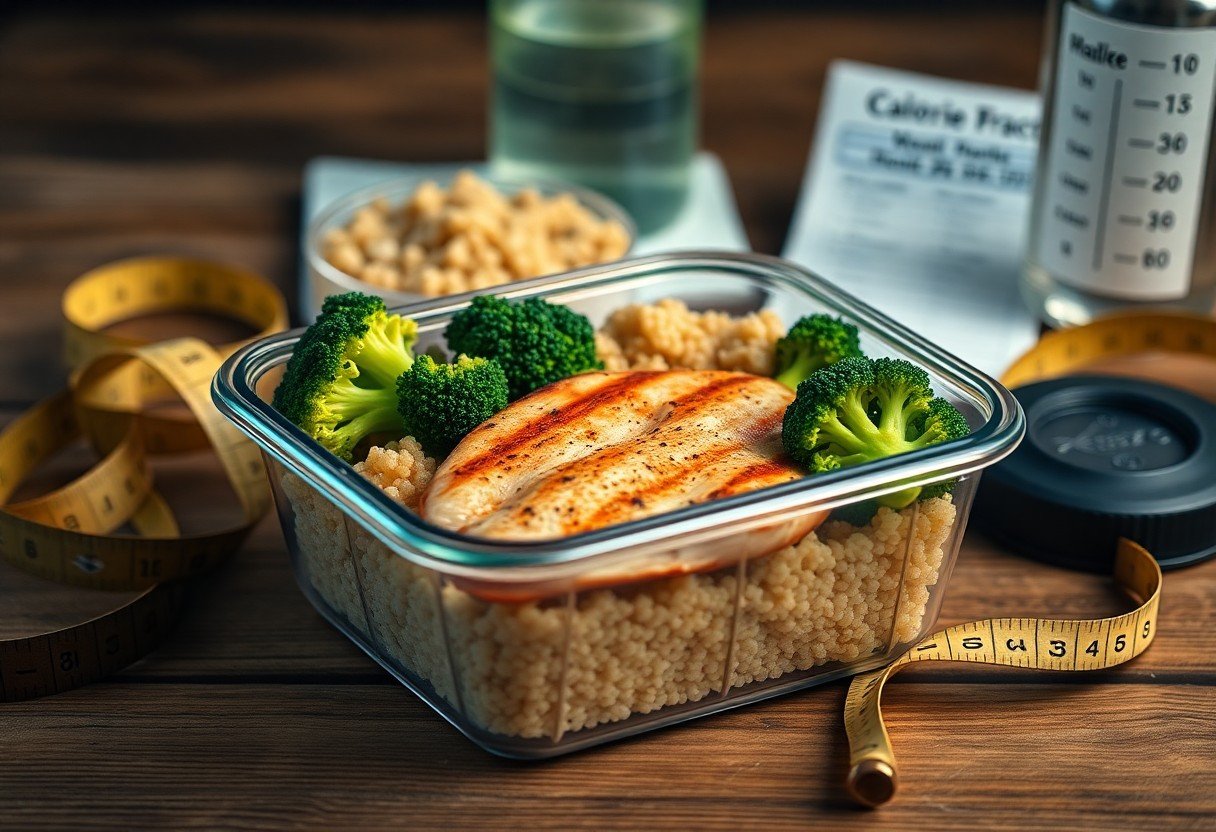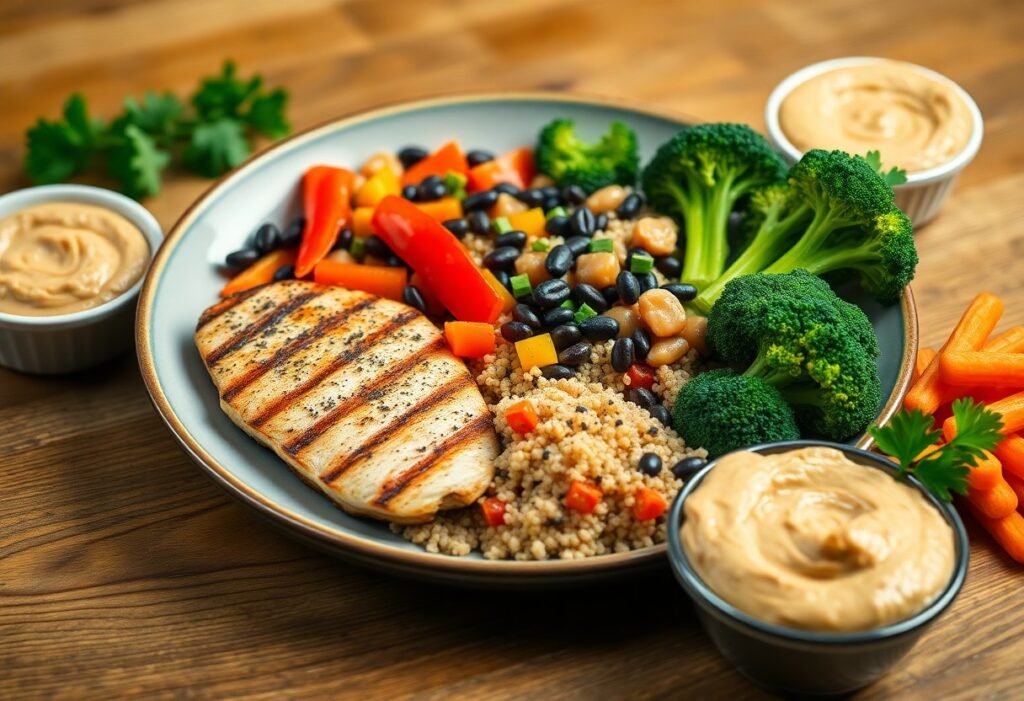Most weight loss strategies suggest strict diets that leave you feeling deprived, but you can achieve your weight loss goals by understanding the calorie deficit principle. By consuming fewer calories than your body needs, you will naturally encourage fat loss while still enjoying your favorite foods. This guide will show you how to create a sustainable calorie deficit, helping you lose weight effectively without the pain of starvation. Embrace a balanced approach to eating that keeps you energized and satisfied as you initiate on your weight loss journey.
Key Takeaways:
- Establish a sustainable calorie deficit by tracking food intake and adjusting portion sizes.
- Prioritize nutrient-dense foods to maintain energy levels while losing weight.
- Incorporate regular physical activity to enhance fat loss and support overall health.
Understanding Calorie Deficit
What is a Calorie Deficit?
A calorie deficit occurs when you consume fewer calories than your body needs to maintain its current weight. For instance, if your body requires 2,000 calories daily for maintenance but you only intake 1,500, you create a deficit of 500 calories. Over time, this deficit can lead to weight loss as your body burns stored fat for energy.
Importance of Caloric Balance
Caloric balance is the relationship between calories consumed and calories expended through physical activity and metabolism. Achieving a caloric deficit is necessary for weight loss, while a surplus can lead to weight gain. This balance is necessary for guiding your weight management strategy effectively.
Your weight loss journey hinges on maintaining this balance. For instance, if you’re not mindful of your intake versus output, you may unintentionally overconsume food or neglect physical activity, nullifying your efforts. The key is to regularly monitor your caloric intake and adjust based on your body’s feedback, ensuring you remain on track toward your goals.
How Calorie Deficits Affect Weight Loss
Calorie deficits are the foundation of weight loss. When your body is in a deficit, it resorts to burning stored fat for energy, leading to weight reduction. The greater the deficit, the faster the potential weight loss, but it’s important to aim for a gradual decrease to maintain muscle mass and overall health.
It’s vital to strike a balance with your calorie deficit. A standard recommendation is to aim for a deficit of 500 to 1,000 calories per day, leading to a safe and sustainable weight loss of about 1 to 2 pounds weekly. Drastic reductions can lead to muscle loss and metabolic slowdown, so focus on combining a moderate deficit with a nutritious diet and exercise regimen for the best results.
How to Create a Calorie Deficit
Assessing Your Daily Caloric Needs
To effectively create a calorie deficit, you first need to determine your daily caloric needs. This is based on factors like your age, sex, weight, height, and activity level. Numerous online calculators can provide a reliable estimate, or you can refer to guidelines from health organizations. Understanding your maintenance calories allows you to adjust your intake accordingly. For more insights, check out Weight loss: Feel full on fewer calories.
Calculating Your Calorie Deficit
Once you’ve assessed your daily caloric needs, you can calculate your calorie deficit. A typical recommendation for safe weight loss is to aim for a deficit of 500 to 1,000 calories per day, which can result in a loss of about 1 to 2 pounds per week. This involves consuming fewer calories than you burn, leading to fat loss over time.
For instance, if your maintenance calories are 2,500, consuming 2,000 calories daily will create a 500-calorie deficit. It’s crucial to balance this by making nutritious food choices to maintain overall health. Tracking your food intake with apps or journals can simplify this process and keep you accountable.
Tips for Reducing Caloric Intake
Reducing caloric intake can be straightforward with some mindful strategies. Incorporate these habits to help you create a calorie deficit:
- Focus on whole foods, such as fruits and vegetables.
- Eat smaller portions to prevent overeating.
- Limit high-calorie beverages, like sugary drinks.
- Choose lean proteins to keep you full.
- Plan your meals to avoid impulsive eating.
After adopting these strategies, you’ll likely notice that it’s easier to stay within your calorie limits while still feeling satisfied.
To enhance your calorie reduction further, try these additional tips:
- Incorporate more fiber to improve satiety.
- Reduce snacking between meals.
- Cook at home to control ingredients and portion sizes.
- Increase your water intake to curb unnecessary hunger.
- Limit processed foods that are high in calories but low in nutrients.
After implementing these changes, you’ll likely find it easier to maintain a healthy and sustainable calorie deficit.

Tips for Sustainable Weight Loss
- Focus on a moderate, sustainable calorie deficit.
- Prioritize whole foods over processed options.
- Practice portion control to manage intake.
- Implement meal planning for better choices.
- Utilize a food journal to track your habits.
Incorporating More Whole Foods
Boost your nutrient intake by emphasizing whole foods such as fruits, vegetables, whole grains, and lean proteins. These foods are typically lower in calories and packed with important vitamins and minerals, promoting satiety and improving overall health. For optimal results, aim to fill your plate with a variety of colorful options, ensuring a well-rounded nutrient profile.
Understanding Portion Control
Grasping portion control is vital to maintaining a healthy caloric intake. Use measuring cups or a food scale to comprehend serving sizes better, ensuring you don’t inadvertently consume extra calories. Realizing standard serving sizes can help you balance your meals effectively.
Practicing portion control allows you to enjoy your favorite foods without overindulging. By visualizing proper servings, like using your hand to gauge portions, you can make better choices. Eating mindfully-slowing down and savoring each bite-also helps your body recognize when it’s full, reducing the chance of overeating.
Importance of Meal Planning
Establishing a routine of meal planning can significantly streamline your weight loss efforts. When you plan your meals in advance, you minimize impulsive eating and ensure you include balanced options that adhere to your calorie goals. This strategy also allows you to prepare healthy snacks and avoid the temptation of unhealthy choices.
Effective meal planning encourages thoughtful choices, enabling you to map out your week’s meals based on your nutritional needs. Preparing meals ahead of time means you have healthy options readily available, reducing reliance on convenient but often unhealthy fast food. By dedicating some time each week for planning, you can stay organized and focused on your weight loss journey.
Keeping a Food Journal
Utilizing a food journal can enhance your awareness of eating habits and patterns, making it easier to identify areas for improvement. Tracking what and when you eat provides insights into your caloric intake and helps you hold yourself accountable. This practice can shine a light on emotional eating or portion distortion, enabling targeted changes.
Maintaining a food journal can be a powerful tool. By committing to writing down each meal and snack, you can reflect on your choices and understand your triggers. Over time, this awareness fosters better decision-making, allowing you to adjust your diet as needed to support your weight loss goals. Knowing you have to log your food can encourage healthier eating habits and your overall progress.
Factors Influencing Weight Loss
- Metabolism
- Age
- Hormones
- Lifestyle Factors
Any understanding of these factors will enhance your weight loss journey.
Metabolism and Its Role
Your metabolism plays a significant role in weight loss. It’s the process by which your body converts food into energy. A higher metabolic rate means you burn calories faster, which can facilitate a successful calorie deficit. Individual differences in metabolic rates can be influenced by muscle mass, genetics, and physical activity levels.
The Impact of Age on Weight Loss
As you age, your metabolism tends to slow down, making weight loss more challenging. This decrease can be attributed to the loss of muscle mass and hormonal changes, meaning you may need to adjust your caloric intake and exercise routine to maintain a calorie deficit.
Moreover, around the age of 30, people can lose up to 3-8% of muscle mass per decade, leading to reduced calorie expenditure. Consequently, it becomes imperative to incorporate strength training and focus on protein intake to preserve muscle while losing weight.
Hormonal Factors to Consider
Your body’s hormonal balance greatly influences weight loss. Hormones like insulin, cortisol, and leptin regulate hunger, metabolism, and fat storage. An imbalance can hinder your weight loss efforts and increase cravings, making it harder to maintain a calorie deficit.
- Insulin
- Cortisol
- Leptin
Knowing your hormonal levels can give you insights into your weight loss challenges.
Hormonal fluctuations, such as those related to puberty, menopause, or pregnancy, can significantly affect your appetite and fat distribution. For instance, increased cortisol levels from stress can lead to weight gain, particularly in the abdominal area. Monitoring these changes is imperative for effective weight management.
- Cortisol
- Thyroid Hormones
- Estrogen
Knowing your body’s hormonal patterns can aid in tailoring your weight loss strategies.
Lifestyle Factors: Sleep and Stress
Both sleep and stress significantly impact your weight loss efforts. Insufficient sleep can disrupt hormones that regulate hunger, leading you to consume more calories. Likewise, elevated stress levels can result in emotional eating and increased cravings for unhealthy foods.
- Sleep Quality
- Stress Management
- Emotional Eating
Assume that improving your sleep and stress levels will support your weight loss journey.
Practicing good sleep hygiene and adopting effective stress management techniques can enhance your efforts. Establishing a regular sleep schedule and engaging in relaxation exercises such as mindfulness can improve your overall well-being, making it easier for you to maintain a calorie deficit.
- Sleep Hygiene
- Mindfulness
- Physical Activity
Assume that adopting these healthier lifestyle habits will pave the way for sustainable weight loss.

Exercise and Calorie Deficit
Types of Exercise to Complement Weight Loss
Incorporating different exercise types can significantly enhance your weight loss journey. The main forms include cardiovascular workouts for fat burning, strength training for muscle building, and flexibility exercises for overall wellness. Each type plays a unique role in achieving a balanced fitness routine.
| Type of Exercise | Benefits |
|---|---|
| Cardio | Burns calories and improves heart health |
| Strength Training | Builds muscle, boosts metabolism |
| Flexibility | Enhances range of motion and prevents injury |
| HIIT | Quick, effective fat loss |
| Group Classes | Motivation and social support |
Balancing Cardio and Strength Training
Finding the right balance between cardio and strength training is key to effective weight loss. Integrating both into your weekly routine can maximize calorie burn while preserving muscle mass. Aim for at least 150 minutes of moderate-intensity cardio and two days of strength training per week.
When planning your workouts, consider alternating between cardio and strength training. This approach allows you to target different muscle groups, reducing the risk of injury and enhancing recovery. Combining these types of exercises not only supports weight loss but also improves overall fitness and stamina.
Tips for Staying Active Throughout the Day
Incorporating more activity into your daily routine can boost weight loss without overhauling your schedule. Consider these strategies to enhance your activity levels:
- Take the stairs instead of elevators
- Use a standing desk for work
- Walk during phone calls
- Engage in household chores actively
- Park further away from your destination
After integrating these simple habits, you’ll notice a significant increase in your overall energy expenditure.
Including activities throughout your day doesn’t have to be complicated. Aim to take short breaks for movement, stretch during work, and find opportunities to walk more. Small, consistent efforts add up and contribute to your weight loss goals.
- Take walking meetings when possible
- Set reminders to move every hour
- Incorporate short workouts into your breaks
- Join a local sports league or class
- Opt for active weekend outings
After implementing these strategies, you can effortlessly increase your daily energy expenditure, supporting your weight loss journey.

Mindset and Motivation
Setting Realistic Goals
When launching on your weight loss journey, setting realistic goals is imperative. Aim for a gradual weight loss of 1-2 pounds per week, as this is generally considered safe and achievable. Break down your overall goal into smaller milestones, like losing 5% of your body weight, which can enhance your motivation and provide a tangible sense of accomplishment.
Staying Motivated During Your Journey
Keeping your motivation high can be challenging, but focus on finding activities you enjoy. Incorporating exercise into your routine, such as joining a dance class or hiking with friends, can make the process enjoyable. Additionally, tracking your progress through apps or journals can help you remain committed to your goals.
Consider connecting with a community, whether online or in-person, to share experiences and challenges, which can foster accountability. Celebrate your small victories, such as consistently hitting your workout targets or making healthier food choices. These moments of success can boost your morale and reinforce your commitment to your weight loss journey.
Dealing with Setbacks
Setbacks are a natural part of any weight loss journey, but how you handle them can dictate your long-term success. Instead of viewing a slip-up-like indulging in a dessert or skipping a workout-as a failure, see it as an opportunity to learn and adjust your approach.
Recognizing that weight loss is not a linear process helps in maintaining a positive outlook. Analyze what led to the setback, and develop strategies to avoid similar situations in the future, such as preparing healthier snack options or scheduling workouts into your calendar. It’s paramount to be compassionate toward yourself and focus on your ultimate goals, rather than dwelling on temporary challenges.
Conclusion
So, embracing a calorie deficit doesn’t mean you must starve yourself. By understanding your body’s energy needs and making mindful food choices, you can create a sustainable weight loss plan. Focus on whole foods, balance your meals, and incorporate regular activity to enhance your results. With this approach, you can effectively lose weight while still enjoying your favorite meals and maintaining your overall well-being.
FAQ
Q: What is a calorie deficit?
A: A calorie deficit occurs when you consume fewer calories than your body expends, leading to weight loss over time.
Q: How many calories should I cut to create an effective calorie deficit?
A: A daily deficit of 500 to 1000 calories can lead to a weight loss of about 1 to 2 pounds per week, which is considered safe and sustainable.
Q: Can I lose weight without extreme dieting?
A: Yes, sustainable weight loss is possible through gradual changes in diet and exercise, focusing on balanced meals and regular physical activity rather than severe restrictions.
Q: What types of foods should I focus on while in a calorie deficit?
A: Prioritize whole foods like fruits, vegetables, lean proteins, whole grains, and healthy fats to ensure you’re getting vital nutrients while managing calorie intake.
Q: How can I track my calorie intake effectively?
A: Utilize mobile apps or food journals to monitor your daily calorie consumption, making it easier to stay within your deficit while ensuring nutritional needs are met.









